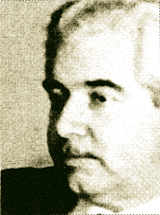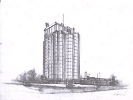U.Porto Memory
University of Porto Famous Alumni
Agostinho Ricca
 |
Agostinho Ricca 1915-2010 Architect and teacher |
 Agostinho Ricca Gonçalves was born in Porto on 9 July 1915.
Agostinho Ricca Gonçalves was born in Porto on 9 July 1915.
He attended the Architecture course at the Porto School of Fine Arts, which he completed in 1941 with the final mark of 18 out of 20. He was taught by Marques da Silva. During the course, he received two prizes, the Life Drawing Prize, in the 2nd year, and the "3 Arts Competition" Prize.
 After he graduated, he trained with architect Januário Godinho, joined the Department of Urban Planning of the Porto City Council (1940-1945), where he collaborated with Italian architect Giovanni Muzio in the 1st Urban Plan of the City (1893-1982), and worked with Rogério de Azevedo (1941) at the Directorate General for National Buildings and Monuments, namely in the restoration of the Paços dos Duques de Bragança building, in Guimarães.
After he graduated, he trained with architect Januário Godinho, joined the Department of Urban Planning of the Porto City Council (1940-1945), where he collaborated with Italian architect Giovanni Muzio in the 1st Urban Plan of the City (1893-1982), and worked with Rogério de Azevedo (1941) at the Directorate General for National Buildings and Monuments, namely in the restoration of the Paços dos Duques de Bragança building, in Guimarães.
From 1943 on, he began to work as a liberal architect.
He joined the 1st National Congress of Architecture (1948), helped found the Organization of Modern Architects, participated in the ODAM exhibition held in Ateneu Comercial do Porto (1951), in the 3rd Biennial Exhibition of S. Paulo (1952), in the 3rd Congress of the International Union of Architects (1953), in Lisbon, and, later, in the "Portuguese Contemporary Architecture Exhibition: 1960's – 1080's", held in the Fundação de Serralves, in Porto, in 1991.
 In 1953, the architect and teacher Carlos Ramos invited him to teach Architecture at the ESBAP, a role he accepted although he would abandon it in 1959 for political reasons. He returned to teaching in 1977. In 1980, he abandoned teaching for good.
In 1953, the architect and teacher Carlos Ramos invited him to teach Architecture at the ESBAP, a role he accepted although he would abandon it in 1959 for political reasons. He returned to teaching in 1977. In 1980, he abandoned teaching for good.
 In the many trips he made to Europe and America throughout his career (Finland, Germany, Holland, Switzerland, USA, etc.) he sought to study the great works of architecture, not only of the pioneers of modernity but also the new generations of architects. These experiences helped him create an original work, in which he valued aspects such as the excellence of the place and the properties of materials. And to produce an art that reflects his passion for other arts, such as painting, sculpture and music.
In the many trips he made to Europe and America throughout his career (Finland, Germany, Holland, Switzerland, USA, etc.) he sought to study the great works of architecture, not only of the pioneers of modernity but also the new generations of architects. These experiences helped him create an original work, in which he valued aspects such as the excellence of the place and the properties of materials. And to produce an art that reflects his passion for other arts, such as painting, sculpture and music.
In the first phase of his career, he was influenced by the architecture of the Beaux-Arts, by Victor Laloux (1850-1937) and Willem Dudock (1884-1969); in the next phase, he was seduced by Alvar Aalto's modernism (1898-1976), Le Corbusier (1887-1965) and Frank Lloyd Wright (1867-1959); finally, he was inspired by post-modernism, by architects like Jean Nouvel (1945-) and Carlo Scarpa (1906-1978).
 Among his architectural works, reference to the Finishing Competition in Júlio Dinis Street and Mouzinho de Albuquerque Square, with Benjamim Carmo (1956); a housing complex, in Júlio Dinis Street (1960-1961); a housing complex in Boavista (1962-1973), in collaboration with João Serôdio and José Carlos Magalhães Carneiro, which includes the church of Nossa Senhora da Boavista (1975-1979), decorated, by Júlio Resende and Zulmiro de Carvalho among others; a project for the "Palácio da Música" [Music Hall] for the City Park (not carried out), in Porto; a beach house in Valadares (1962), Vila Nova de Gaia; Santo Tirso City Council premises (1970); the industrial buildings of EFACEC, in Leça do Balio (1948/1984); the Palace of Justice in Baião (1980's); Santo António Sanctuary, in Vale de Cambra (1993); the church of the Sagrada Família, Chaves (1995); and the project for the Institute of Father Himalaya, shown at the 11th International Biennial Art Exhibition of Vila Nova de Cerveira (2001).
Among his architectural works, reference to the Finishing Competition in Júlio Dinis Street and Mouzinho de Albuquerque Square, with Benjamim Carmo (1956); a housing complex, in Júlio Dinis Street (1960-1961); a housing complex in Boavista (1962-1973), in collaboration with João Serôdio and José Carlos Magalhães Carneiro, which includes the church of Nossa Senhora da Boavista (1975-1979), decorated, by Júlio Resende and Zulmiro de Carvalho among others; a project for the "Palácio da Música" [Music Hall] for the City Park (not carried out), in Porto; a beach house in Valadares (1962), Vila Nova de Gaia; Santo Tirso City Council premises (1970); the industrial buildings of EFACEC, in Leça do Balio (1948/1984); the Palace of Justice in Baião (1980's); Santo António Sanctuary, in Vale de Cambra (1993); the church of the Sagrada Família, Chaves (1995); and the project for the Institute of Father Himalaya, shown at the 11th International Biennial Art Exhibition of Vila Nova de Cerveira (2001).
He died on 17 January 2010, at the age of 94.
(Universidade Digital / Gestão de Informação, 2010)
Last updated: 2024-05-27 Webpage created on: 2024-07-27 13:06:08 Complaint Portal